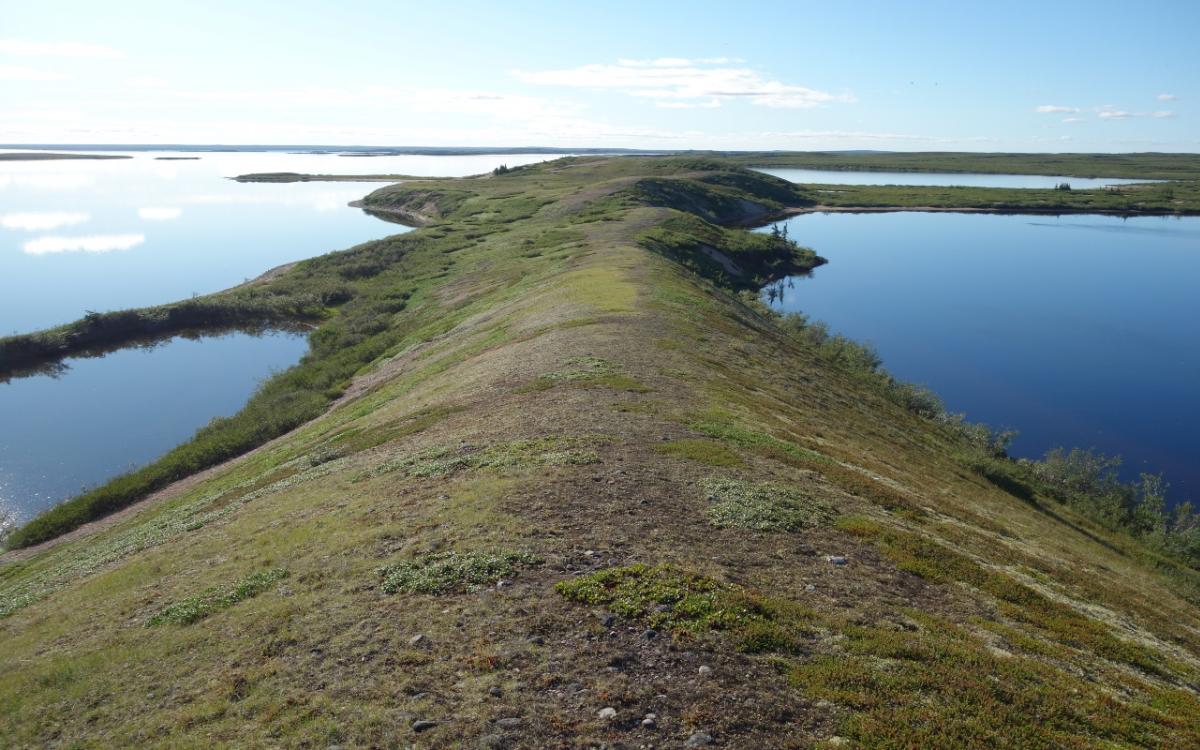The treeless, rolling tundra stretches to the horizon. The tallest plants are the knee-high dwarf birch. But in the distance, if one squints a little, there’s a bright long line of bare sand dotted with spruce. The map confirms this is an esker; a long winding ridge of sediment—mostly sand and gravel—that snakes across the otherwise flat landscape.
These winding eskers—up to 100 metres high—occupy a mere two to three per cent of the tundra landscape, but ecologically they are the crown jewels of the Barrenlands. Drifting snow accumulates alongside eskers in the winter and persists well into summer on the north-facing slopes. Caribou use these snow patches to stay cool and escape insects, while some Arctic plants that live on the north-facing slopes can otherwise only be found much further north in the Arctic.
Similarly, the hot, south-facing slopes provide a warmer microclimate; one that can be home to spruce trees far north of the tree line. Wolves, foxes, and grizzly bears rely heavily on eskers for denning sites, while caribou often follow eskers on their migration routes. Eskers have also been used by Indigenous peoples for travel, hunting, and burial sites.
But how are they created? What’s in the core of these eskers? Why are they so regularly spaced throughout the tundra? And why are these long ridges all roughly the same size? While there are a handful of theories that attempt to explain these questions, the truth behind eskers remains a tantalizing mystery.
“Eskers in the barrens are like hot dogs,” says Don Cummings, a researcher at Carleton University in Ottawa. “We know what they look like, but we don’t really know what’s inside.”
Scientists generally agree that eskers form from sediment deposited by meltwater as glaciers retreat. The theory is that a river on or under the glacier deposits sediment as the ice melts. But the analogy of a modern river fails us. Whereas rivers increase in size along their length, eskers show no similar change. The central ridges of eskers tend to be the same size regardless of location. River bottoms also have large particles—boulders—at the river source, and finer and finer particles as you travel downstream. But eskers don’t show such a continuous transition to finer particles. Rivers can move sediment for thousands of kilometres. But with the eskers, sampling shows that sediment doesn’t move very far from its source—perhaps a hundred kilometres at most—even when the esker can be much longer.
Some of these mysteries can be explained by meltwater on top of the glacier dropping through a crack or hole to the bottom and flowing towards the glacier’s edge in an ice tunnel. The water picks up sediment from dirty ice or from the ground, before meeting a lake at the edge of the glacier. This part is critical, as it would allow vertical space for the sediment to accumulate in the sort of fan-like shapes that are commonly seen alongside eskers. Heavier, larger sediment is deposited in the ice tunnel as a ridge, while smaller, lighter sediment, such as sand, is deposited in a fan at the ice edge. Slowly, over thousands of years, the esker forms as the ice edge retreats.
While many eskers around the world have been extensively studied, those in Canada’s northern tundra are poorly understood. At Diavik Diamond Mine in the Northwest Territories, for instance, an esker being used as a gravel source was surprisingly found to contain a two-metre thick core of glacial ice.
The Northwest Territories Geological Survey has funded recent research including a study on the world’s longest esker, the Exeter Lake Esker. This 800-kilometre long ridge stretches from the Northwest Territories’ eastern border with Nunavut nearly all the way to Great Bear Lake.
Research continues on these geological formations in an attempt to find answers to how they were formed, and how sampling of eskers can help find minerals of interest, such as diamonds.









